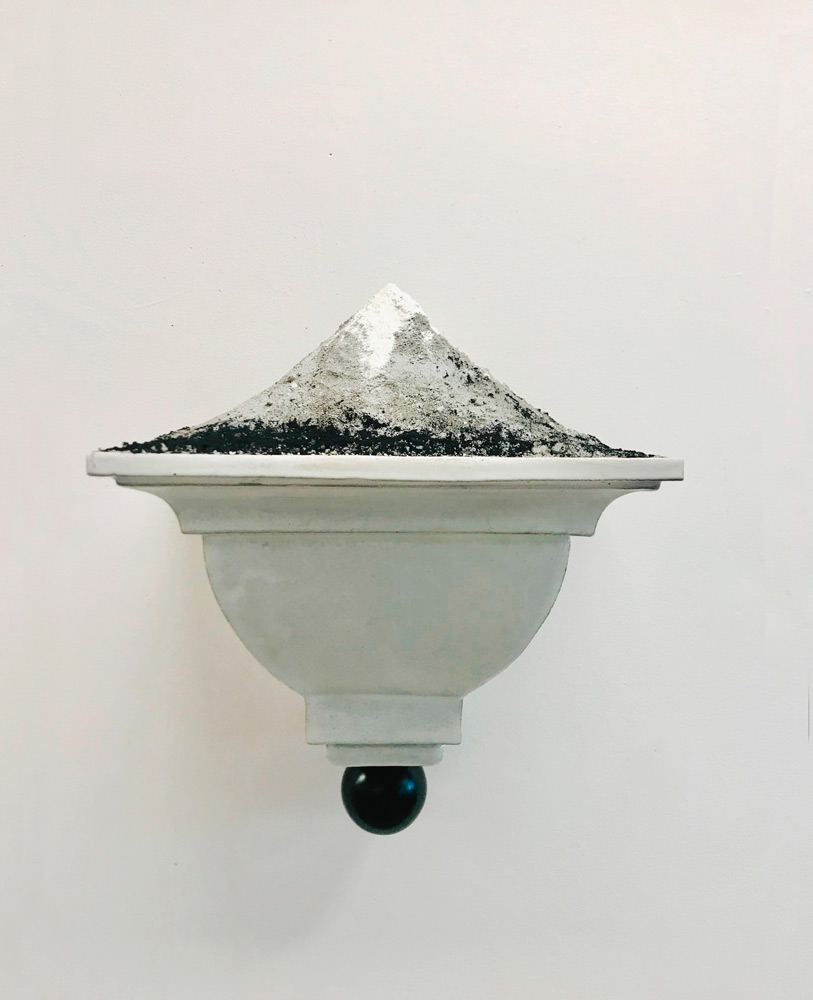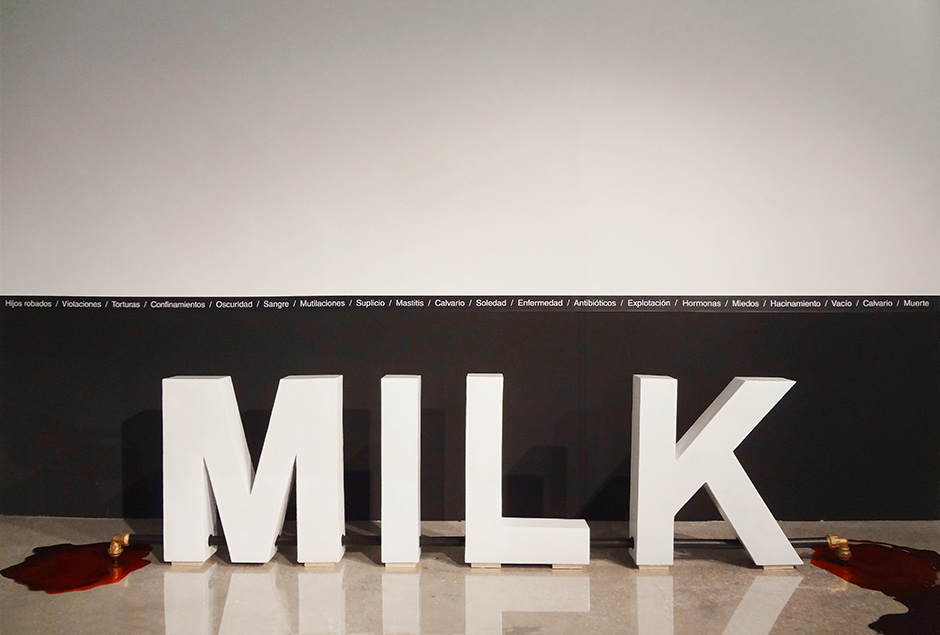SUEÑO FUNÁMBULO · C.E.A.R.T. Centro de Arte Tomás y Valiente. Madrid · AÑO: 2015
Texto: Marisol Salanova
El Sueño Funámbulo de Deva Sand
La obra de Deva Sand inmediatamente remite al espacio privado, a la meditación, pasando por tres fases identificables en la exposición Sueño Funámbulo, a saber, introspección, transición y expansión. Esta muestra permite poner en diálogo piezas de diferentes etapas con un mismo trasfondo que, liberado de prejuicios, obliga al espectador a emprender un viaje de descodificación, desconfiguración, para ver más allá de la forma del objeto en un mundo en el que resulta difícil escapar a la doble moral y encontrar el equilibrio.
Un sueño lúcido se caracteriza porque el soñante es consciente de estar soñando, pudiendo alterar la logica de los acontecimientos a su voluntad. Quien visita la exposición de Deva Sand experimenta esa sensación ambigua y vivificante del paseo onírico, animado a reflexionar sobre su intimidad y asomarse a los pensamientos, alegrías, miedos e inquietudes del otro, en este caso de la artista, en un intento por esquivar la pérdida de la consciencia de soñar. Es ahí donde el visitante se convierte en un funambulista que puede recorrer de puntillas la cinta adhesiva que dibuja una casa completa en el suelo de la estancia y acabar contemplando el florecer de una planta de la que germinan dientes.
La parte central de la muestra es un lugar de transición, una puerta hacia lo invisible, nos habla de lo doméstico y de cómo el mobiliario que nos rodea puede influir en nuestro ánimo así como adquirir otro sentido diferente al esperado. Sin duda la artista parte de la casa como metáfora del cuerpo humano y la disposición alargada de la sala propone un recorrido que es como la idea de entrar en uno mismo, excavar en el propio interior y mirar más allá de las apariencias, instrospectivamente, provocando la estancia un diálogo del espectador o visitante consigo a través de una mirada retrospectiva al trabajo de Sand.
En el momento de expansión se aprecia la búsqueda de una simbiosis con la naturaleza, particularmente con las plantas. Por primera vez en su carrera la artista incorpora de una manera clara figuras humanas para convertirlas en protagonistas de collages en los que se retorna constantemente a los orígenes para señalar la fragilidad humana y nuestra cercanía con la tierra, el campo, la naturaleza que recoge nuestros restos corporales. Podría interpretarse que el retorno a la tierra representa un regreso al útero, el comienzo femenino de la vida, y al mismo tiempo a la tumba, donde se sitúa la muerte, presente para todos a veces simbólicamente como regeneración, pues un objeto puede tener muchas vidas diferentes y tal vez una persona también.
Sand hace lo mismo que la naturaleza en el sentido de que encuentra objetos y les da otra vida, una segunda vida, descontextualizados respecto de su utilidad inicial o su localización original. Esos objetos renovados, manipulados y convertidos en obras de arte forman parte del imaginario mental de la artista, también los dibujos que componen sus collages. Todo lo que vemos a nuestro alrededor es orgánico, como una piel que recubre la sala de una amalgama ecléctica. Sensible y abstraida la artista nos lleva al borde del abismo así que acabamos reaccionando y tomando conciencia de que vivimos acrobacias mortales en una mudanza incesante que nos mantiene despiertos.
Marisol Salanova, crítica de arte y comisaria.
The Dream on a Tightrope by Deva Sand
Deva Sand’s work takes us immediately into a private space, to meditation, via three identifiable phases in the exhibition entitled Dream on a Tightrope, namely introspection, transition and expansion. This exhibition lets us include in the dialogue pieces from different times but with the same background, which, free from prejudice, forces the viewer to set off on a journey of decodification, deconfiguration, to look beyond the shape of the object into a world where it is no easy task to flee from double standards and find balance.
A lucid dream is defined by the fact that the dreamer is aware he is dreaming, and can change the logic of what happens at will. Whoever visits Deva Sand’s exhibition will experience this ambiguous and vivifying sensation of an oneiric journey, encouraged to reflect on his intimacy, and to lean over into the thoughts, joys, fears and concerns of – in this case – the artist, in an attempt to avoid the loss of the awareness of dreaming. It is here that the viewer becomes a tightrope walker, moving in tiptoe along the sticky tape that draws a whole house on the ground of the room, to end up contemplating the blossoming of a plant sprouting teeth.
The central part of the exhibition is an area of transition, a doorway to the invisible, speaking of the domestic and how the furniture that surrounds us can affect our state of mind and take on a meaning different from what was expected. No doubt the artist starts with the house as a metaphor of the human body and the extended layout of the room proposes a route like the idea of going inside yourself, digging into your inner self and looking beyond appearances, instrospectively. The room leads to a dialogue of the viewer or visitor with himself by means of a retrospective look at Sand’s work.
When it comes to expansion we can see the search for a symbiosis with nature, especially with plants. For the first time in her career the artist has clearly incorporated human figures in order to turn them into protagonists in collages, in which we are constantly taken back to the roots to show human fragility and our closeness to the earth, the countryside, nature, which holds our bodily remains. It could be understood that going back to the earth represents a return to the womb, the feminine start of life, and at the same time to the grave, where death lies, present for everyone, at times symbolically as regeneration, as an object can have many different lives – and maybe a person can too.
Sand does the same as nature in the sense that she finds objects and gives them another life, a second life, decontextualized in regard to their initial utility or their original place. These renovated objects, manipulated and turned into works of art, form part of the artist’s mental imagery, as do the drawings that make up her collages. Everything we see around us is organic, like skin covering the room with an eclectic amalgam. Sensitive and absorbed, the artist takes us to the edge of the abyss and so we end up reacting and becoming aware that we are living mortal acrobatics in unceasing change, which keeps us awake.
Marisol Salanova, art critic and curator.








